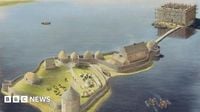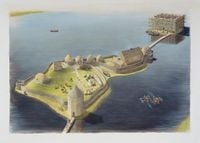Archaeologists have unveiled the lost story of a royal stronghold at Finlaggan, on Scotland’s Isle of Islay—a discovery that is rewriting what historians thought they knew about the medieval power structures of western Scotland. After nearly three decades of painstaking research and analysis, the findings were published this week in The Archaeology of Finlaggan, Islay, a comprehensive volume from the Society of Antiquaries of Scotland. The work, led by Dr. David Caldwell, has revealed a castle complex that may have housed kings who ruled vast territories more than 700 years ago, predating the famous Lords of the Isles by centuries.
It all began with a series of archaeological excavations at Finlaggan between 1989 and 1998. The site, nestled in Loch Finlaggan, had long been shrouded in mystery and legend—locals whispered of ancient kings and lost palaces, but until now, little hard evidence existed. That changed as researchers unearthed the remains of a castle that once spanned two small islands, its foundations telling a tale of power, wealth, and ambition.
According to The Independent, one of the islands was dominated by a massive rectangular stone tower, measuring approximately 19 by 19 meters. This imposing keep, comparable to those found in English castles at Carlisle, Bamburgh, and Lancaster, served as both a fortress and the living quarters for the resident king or lord. The design wasn’t just about protection—it was a bold political statement. As Dr. Caldwell’s team discovered, such large rectangular stone towers were essentially the domain of great Anglo-French lords and kings in Britain and Ireland, signaling royal connections and a claim to authority.
The second island was no less impressive. Archaeological evidence points to extensive courtyards filled with kitchens, workshops, houses, and a great hall where medieval feasts would have echoed across the loch. There was even a chapel, complete with its own burial ground—a feature typically reserved for royal residences. The sophistication of the complex, as reported by the BBC, suggests that Finlaggan was far more than a remote outpost; it was the ceremonial, administrative, and judicial heart of a kingdom.
But whose kingdom? The story of Finlaggan is deeply entwined with the rise of the MacDonald clan, whose chiefs would later become known as the Lords of the Isles. From around 1300 to 1500 AD, these rulers controlled a vast maritime domain stretching across the Hebrides, Argyll, and parts of the northwest Highlands. They called themselves “Ri Innse Gall”—King of the Isles—and, quite audaciously, treated with Scottish and English royalty as equals. The Lords of the Isles even launched raids on the Scottish mainland, with Urquhart Castle on the shores of Loch Ness among their targets, according to The Scottish Sun.
The newly discovered castle at Finlaggan predates the Lords of the Isles, but it’s clear that the site served as their power base. Excavations revealed casket mounts and keys—used to protect valuable documents—remains of a council house where the Council of the Isles met, and evidence of elaborate ceremonial events. These findings, detailed in Dr. Caldwell’s book, confirm that Finlaggan was the beating heart of a quasi-independent state that challenged the Stewart dynasty for control of much of Scotland.
The site’s significance, however, stretches back even further. Beneath the medieval layers, archaeologists found traces of prehistoric settlement and even hints that Finlaggan may have served as a Viking-age assembly site, or "Thing." Lead mining and post-medieval settlements also left their mark. The castle itself, built in the 12th or 13th century, may have been dismantled due to structural issues or destroyed in enemy attacks before a later palace rose on the same spot in the 14th century, when the MacDonalds reached the zenith of their power.
Dr. Caldwell, reflecting on the decades-long project, told the BBC, “The processing of all the data that was gathered has been a major part of my life since the 1990s and I hope I have not only provided an account of interest but also a basis for others to carry out more research in the future.” His words echo the sense of privilege and responsibility that has accompanied the project, which relied on a dedicated team of specialists and volunteers.
Dr. Helen Spencer, head of research at the Society of Antiquaries of Scotland, emphasized the importance of sharing these discoveries with the wider public. “As a charity, part of our mission is to share knowledge of the past with everyone, which is why we are especially grateful to our thousands of Fellows across the globe,” she said, as reported by The Independent. The Society, founded in 1780, has played a crucial role in bringing to light Scotland’s rich archaeological heritage.
The findings at Finlaggan have not only filled in a missing chapter of Scottish medieval history, but they have also challenged long-held assumptions about the scale and sophistication of power in the region. The grandeur of the castle complex—its stone keep, ceremonial halls, and royal chapel—shows that the rulers of the western isles were operating on a stage as grand as any in Europe. The continuous occupation of the site, from prehistory through the medieval period, speaks to its enduring strategic and symbolic importance.
For historians, archaeologists, and the simply curious, the publication of The Archaeology of Finlaggan, Islay offers a window into a world where island kings built castles to rival those of England and Ireland, where clans carved out their own empires, and where the echoes of feasting and council still seem to linger among the ruins. As new research builds on these foundations, Finlaggan’s story is sure to captivate for generations to come.


